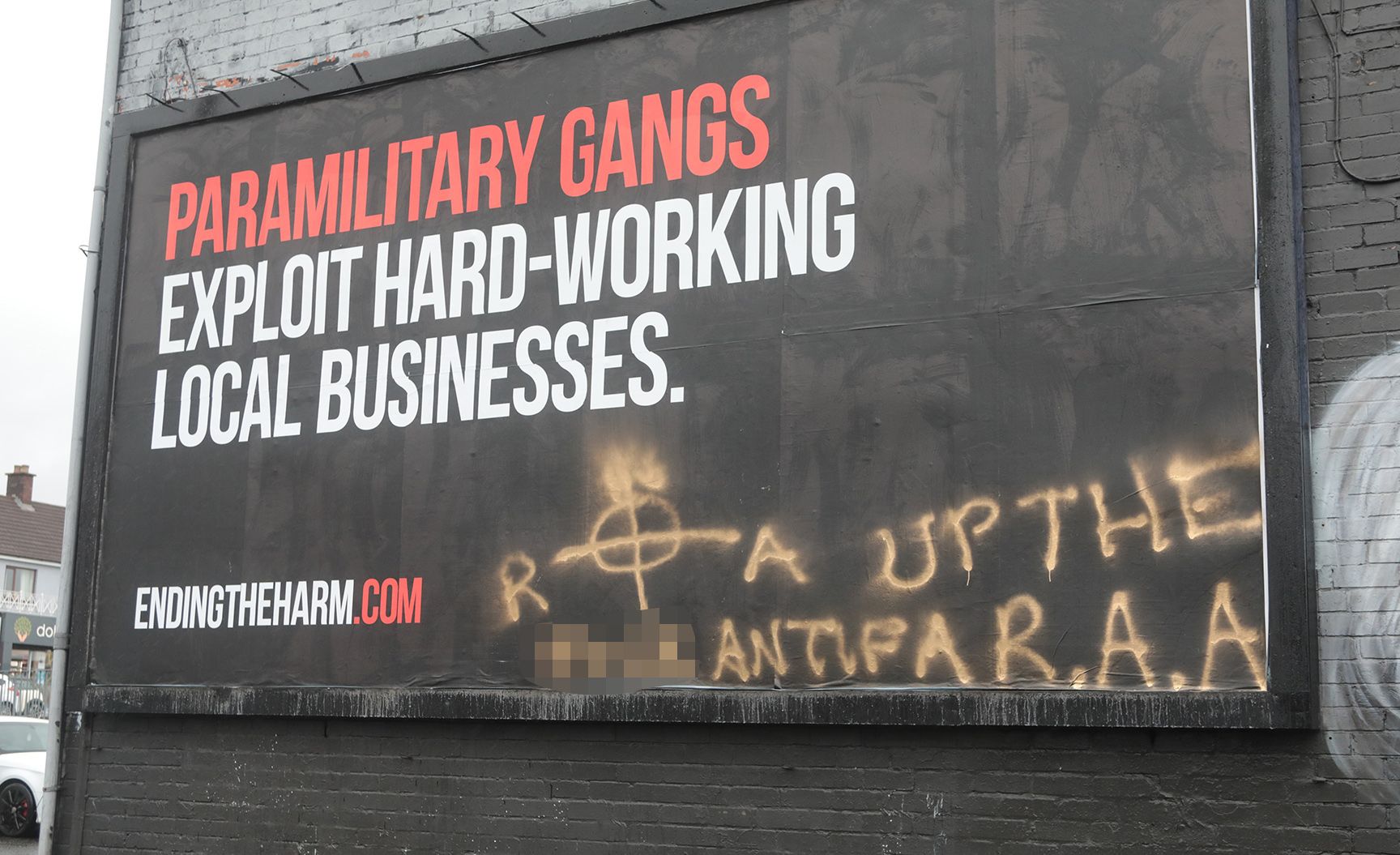THE Department of Justice (DoJ) is refusing to tell the Andersonstown News the locations of billboards in its expensive and controversial ‘Ending the Harm’ campaign.
The billboards proclaim in huge red and white lettering that 'Paramilitary gangs control our communities with violence, intimidation and drug-dealing' and warn of paramilitary abuse of women/girls and child-grooming. The billboards appear to have been placed in exclusively working-class areas of the city, even though paramilitaries are known to operate and live in affluent commercial and residential districts.
Concern is growing – particularly in West Belfast – about the damage the billboards may be doing to trade and investment in the areas in which they’ve been put up. A billboard in Andersonstown, for instance, claiming that paramilitaries control the community, is placed slap-bang in the middle of the commercial heart of West Belfast – on the gable wall of a new business. The billboard has been daubed with four-letter graffiti.
Residents of West Belfast are also unhappy at the message that is being sent out to local people and visitors as they go about their daily lives – the billboards have been variously described to us as “insulting” and “patronising”.
We’ve been attempting to discover exactly where the billboards have been erected across the city in the wake of a powerful challenge by former Finance Minister and Belfast Media Group publisher Máirtín Ó Muilleoir. He’s been the leading voice in the opposition to the billboards, challenging the DoJ over the claim in the billboards that paramilitaries control the community of West Belfast – and criticising the department for avoiding more affluent areas.
Earlier this week, Mr Ó Muilleoir told BBC Radio Ulster that he rejected the claim made in the billboards that paramilitaries control his community – and he said that while there's copious evidence of paramilitaries living and operating in affluent commercial and residential districts in Belfast and more widely across the North, no billboards are to be found there.
UNIMPRESSED: Máirtín Ó Muilleoir, a former Lord Mayor of Belfast, has been leading the charge against the 'insulting' billboards
That point was put to Justice Minister Naomi Long last Friday on Twitter, with Pilib Ó Geibheannaigh asking her: “Are there any [Ending the Harm billboards] in BT9?"
BT9 is the city’s most famously affluent postcode, taking in the wealthiest parts of the Lisburn Road and the Malone district.
Minister Long replied: “Yes. There’s one just up from the City Hospital.”

We dispatched a photographer, but he was unable to find an Ending the Harm billboard above the City Hospital’s BT9 entrance on the Lisburn Road. Neither could he find one in BT9 below the City Hospital.
But after widening his search to the BT12 district of Sandy Row and the Village, he managed to find a double Ending the Harm billboard below the Donegall Road entrance to the City Hospital. The area in which those billboards are situated is one of South Belfast’s most economically challenged.
We sent a series of emails to the DoJ in an attempt to discover if the BT12 Donegall Road billboards were in fact what Minister Long had been referring to in her Tweet referencing BT9 and the City Hospital. But we were unable to secure a response. Declining to tell us if the Donegall Road City Hospital billboards had been what Minister Long was referring to, a DoJ spokesperson told us: “As per previous responses, locations change regularly therefore the Department will not provide running commentary on locations. I can however confirm there have been multiple posters in both BT9 and BT12 areas.”
UNMOVED: Justice Minister Naomi Long insists the 'Ending the Harm' billboard locations are based on 'evidence'
While we've been inquiring about the location of large and hugely expensive billboards, the DoJ response referred only to ‘posters’ in BT9 and BT12. Posters are much more modest and cheaper advertising, often to be found at bus stops.
“The question now is," said Máirtín Ó Muilleoir, "why won't they tell us what they're doing with our money? We’re paying for this very expensive campaign, so I think the least we can expect is for the Department of Justice to tell us where the billboards are situated, especially when this wrong-headed campaign is the subject of so much controversy.”
In an earlier Twitter exchange with our columnist Squinter, Minister Long insisted that the location of the billboards is governed by “evidence”.
She wrote: “Billboards are located right across NI in localities which evidence shows are impacted by ongoing paramilitary-related harms.”
We'll be continuing our attempts to persuade the DoJ to send us the information it has on the location of billboards in the city.





